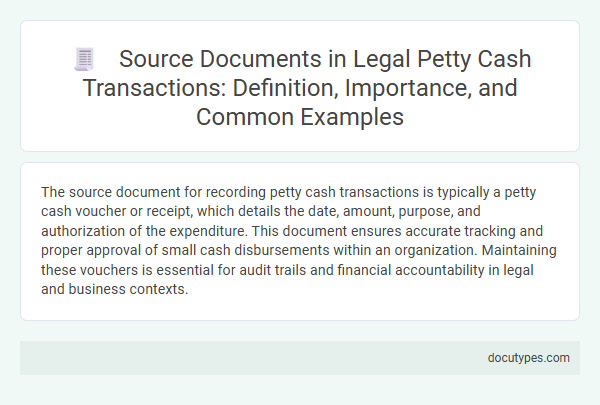The source document for recording petty cash transactions is typically a petty cash voucher or receipt, which details the date, amount, purpose, and authorization of the expenditure. This document ensures accurate tracking and proper approval of small cash disbursements within an organization. Maintaining these vouchers is essential for audit trails and financial accountability in legal and business contexts.
Introduction to Source Documents in Legal Petty Cash Transactions
Source documents serve as the foundational evidence for recording petty cash transactions within legal accounting frameworks. These documents ensure accuracy, transparency, and compliance in financial record-keeping.
- Receipts - Detailed proof of expenses paid out from petty cash, essential for audit trails.
- Voucher Forms - Authorized forms used to document petty cash disbursements before payment.
- Payment Slips - Records confirming the release of petty cash funds for specific transactions.
Maintaining accurate source documents is critical for legal compliance and financial accountability in managing petty cash.
Defining Source Documents in Legal Contexts
Source documents serve as the original records that provide evidence and details of financial transactions, including petty cash expenditures. In legal contexts, these documents are essential for ensuring transparency, accuracy, and accountability in financial reporting.
Common source documents for recording petty cash transactions include receipts, vouchers, and petty cash tickets. These documents must detail the date, amount, purpose, and authorization related to each petty cash disbursement. Proper maintenance and audit of these source documents uphold compliance with legal and regulatory financial standards.
The Role of Source Documents in Petty Cash Management
What is the source document for recording petty cash transactions? Source documents for petty cash transactions include receipts, vouchers, and petty cash tickets that provide proof of expenses. These documents play a crucial role in ensuring accuracy and accountability in petty cash management by verifying each disbursement.
Legal Importance of Accurate Source Documentation
| Topic | Details |
|---|---|
| Source Document for Petty Cash Transactions | The primary source document used for recording petty cash transactions is the petty cash voucher or receipt. This document provides evidence of disbursements made from the petty cash fund, detailing the amount, date, purpose, and recipient of the funds. |
| Legal Importance of Accurate Source Documentation | Accurate source documentation serves as critical legal evidence in financial audits and compliance reviews. It ensures that petty cash transactions are transparent, traceable, and verifiable. Proper documentation protects against fraud, supports internal controls, and fulfills legal obligations for record-keeping. Mismanagement or inaccuracy in petty cash records can lead to legal penalties, disputes, and loss of organizational credibility. |
Types of Source Documents Used in Petty Cash Transactions
The source document for recording petty cash transactions is essential for accurate bookkeeping and expense verification. These documents provide proof of expenditure and support the replenishment process of the petty cash fund.
- Receipts - Official sales receipts or payment slips serve as primary evidence of transactions made using petty cash.
- Petty Cash Vouchers - Internal documents completed by employees detailing the purpose and amount of petty cash used for small expenses.
- Invoices - Vendor invoices may be used when petty cash funds are used to pay for goods or services, providing formal billing details.
Common Legal Requirements for Petty Cash Source Documents
The source document for recording petty cash transactions is typically a petty cash voucher or receipt that provides evidence of the disbursement. Accurate and compliant documentation supports legal audit requirements and internal financial controls.
Common legal requirements for petty cash source documents ensure transparency, authorization, and proper record-keeping under regulatory standards.
- Originality - Source documents must be original and unaltered to serve as valid proof of transactions.
- Authorization - Each petty cash transaction requires prior approval or signature from an authorized personnel for legal accountability.
- Detailed Description - Documents must include a clear description of the expense, date, and amount to comply with audit and tax regulations.
Examples of Source Documents in Legal Petty Cash Usage
Source documents for recording petty cash transactions are essential in legal settings to ensure accurate and verifiable financial records. Examples include petty cash vouchers, receipts, and invoices related to minor office expenses or legal case costs. You must retain these documents to maintain compliance and support audit trails in legal petty cash management.
Best Practices for Maintaining Petty Cash Source Documentation
The source document for recording petty cash transactions is typically the petty cash voucher or receipt. This document details the amount disbursed, the date, and the purpose of the transaction, providing a clear audit trail.
Best practices for maintaining petty cash source documentation involve consistently collecting and organizing all receipts and vouchers in a dedicated ledger or digital system. You should verify each entry regularly to ensure accuracy and prevent discrepancies in the petty cash account.
Legal Risks of Inadequate Source Documents in Petty Cash Systems
The source document for recording petty cash transactions is typically a petty cash voucher, which provides evidence of each disbursement. Inadequate or missing source documents can expose your business to significant legal risks, including challenges during audits and potential fraud allegations. Maintaining accurate and complete petty cash records is essential to ensure compliance with financial regulations and safeguard against legal disputes.
What Is the Source Document for Recording Petty Cash Transactions? Infographic

